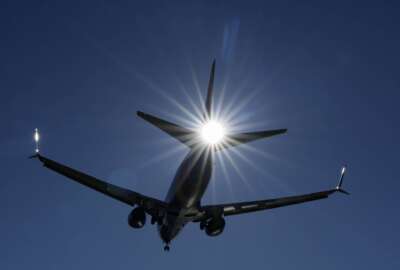FAA rethinks its return-to-office policy, sets lower in-person goal than previously expected
The FAA is setting four days in the office per pay period as a baseline for its workforce, but the agency is giving frontline managers the discretion to set...
The Federal Aviation Administration is bringing its employees back to the office more often later this month — but less often than it previously expected.
The FAA expects telework-eligible employees with approved telework agreements will report in person to their official worksite for an average of four days each two-week pay period, starting Jan. 28.
The agency revised its return-to-office expectations, after getting pushback last summer from the unions that represent the FAA workforce.
The FAA previously announced its employees would return to the office at least three days per week — or six days per pay period — starting on Oct. 9, 2023.
In a Nov. 28, 2023 email sent to all employees, FAA Administrator Mike Whitaker, Deputy Administrator Katie Thomson and more than a dozen senior executives stated the new policy reflects focus groups with FAA managers and talks with union officials.
“While some advocated for increased on-site presence to foster consistent and meaningful collaboration, others stated that leveraging current workplace flexibilities will enhance workforce recruitment,” the email states. “All agreed that building and maintaining a high-performing workforce of dedicated employees and having FAA continue to be a great place to work remain our top priorities.”
An FAA spokeswoman confirmed the agency’s revised return-to-office plans in an email Wednesday.
Many federal employees began heading back to the office more regularly last fall, and some agencies are preparing employees to work in person more often in early 2024.
The Office of Management and Budget directed agencies last year to increase “meaningful” in-office work.
White House Chief of Staff Jeff Zients, in an email to agency leaders last August, urged the federal government to “aggressively execute” a shift toward more in-person work, starting in fall 2023.
The FAA is setting four days in the office per pay period as a baseline for its workforce, but the agency is giving frontline managers the discretion to set in-office expectations for their employees.
“We are providing managers with guidance to ensure the decisions they make about telework agreements focus on mission, operational, and business needs and follow applicable collective bargaining agreements and policy provisions,” the email from FAA leadership states.
FAA leaders also wrote that the agency will continue to work with its labor partners, “and follow all contractual and statutory obligations.”
FAA leaders said a greater in-person presence “allows the FAA to deliver consistently on our growing and evolving mission and to develop the workforce to meet future demands.”
“We commit to continuously assessing our organizational health and ability to meet our evolving priorities. We will remain agile and adjust our posture as operational requirements dictate,” they wrote.
Unions representing FAA employees, however, continue to push back on the agency’s return-to-office plans.
Dave Spero, national president of the Professional Aviation Safety Specialists (PASS), a union that represents 11,000 FAA employees, told Federal News Network in a statement that its collective bargaining agreements require telework requests to be evaluated on a case-by-case basis, and that any decision must be based on business needs.
“A one-size-fits-all, mandatory four-day-per-pay-period requirement is not supported by our CBAs since different operations call for different telework arrangements,” Spero wrote.
“The CBAs set up rules to ensure that any telework arrangements, regardless of the number of telework days or in-person days, meet the agency’s mission needs. Those CBAs remain in full force and effect,” he added.
Jamil Kabbara, president of the American Federation of State, County and Municipal Employees (AFSCME) International Local 1653, said frontline managers may feel pressure from FAA leadership to bring more employees back to the office — and may not have the latitude to set in-person work expectations on a case-by-case basis.
“I know for a fact some of their directors feel that the mission failed because of telework,” Kabbara said. “They have that old mentality, yet they fail to look at and recognize maybe their process and procedures that were written way back needs to be updated — because now there’s a new paradigm.”
AFSCME Local 1653 represents 2,000 FAA employees, including lawyers, economists and aircraft certification engineers.
“The four days [per pay period] is better than the six days, no question about it. It’s a slight improvement,” Kabbara said about the FAA’s revised policy. “But the concern I have is that the agency still did not take the message, and they did not put out a plan, in my opinion, in how to really, truly implement it.”
Kabbara said the union remains concerned with the FAA’s return to office policy, and that agency leadership has offered “no clear vision” on how a greater in-office presence will improve productivity.
“I am concerned by the lack of vision and lack of plan that could cause mass confusion, and that may lead to more grievances. It’s not in the best interest of either the agency or the union to file those grievances, because it’s time-consuming and creates friction,” he said.
He added: “The agency created chaos, in my opinion, between the labor union, the employees, and the management. And even first-line managers are confused,” Kabbara said. “They’re really confused on how they’re going to implement the [new] posture. So the agency is not listening.”
Kabbara said the FAA gave the AFSCME Local 1653 advanced notice about its revised return-to-office plans, and that the union has been in talks with the agency.
However, he said the union and the agency remain divided on the issue.
“There were conversations and discussions. We collaborated, we discussed, but we never negotiated … So we are more in like a discussion mode,” he said. “Nothing has been brought to the table to say, ‘Here’s what we want to talk about. Can we sit down and discuss and negotiate?'”
Kabbara said bargaining unit employees have been more productive with greater access to telework, and that the union has asked the FAA to provide any data that refutes their claim.
“They have failed to provide that information. That makes me tend to believe that they really have no understanding of how things work,” Kabbara said.
“There are some mechanisms that you can use for those that underperform. And we will support that, if you take away their telework or limit their telework and all that. That you can use, instead of penalizing the rest of the group for just one underperforming individual,” he added.
Kabbara said the union is concerned the FAA doesn’t have enough office space to accommodate more employees in the office. He said the agency has downsized on leased office space in recent years.
“The FAA is within its right to bring the employees back to the office, no question about it,” he said. ‘The agency really needs to be more open, sit down at the table [and] negotiate. Let’s work it out together.”
Copyright © 2025 Federal News Network. All rights reserved. This website is not intended for users located within the European Economic Area.
Jory Heckman is a reporter at Federal News Network covering U.S. Postal Service, IRS, big data and technology issues.
Follow @jheckmanWFED






